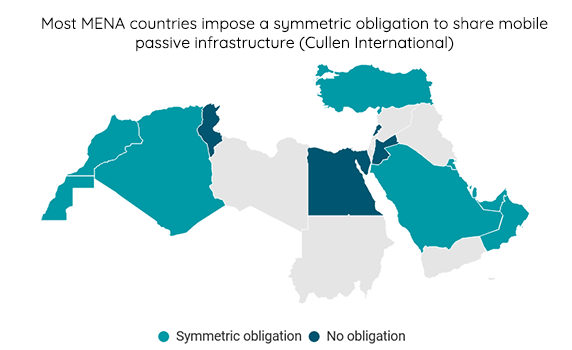Our new benchmark on mobile infrastructure sharing in the Middle East and North Africa region (MENA) sheds light on the main regulatory frameworks for sharing that have been adopted in 13 MENA countries.
The benchmark shows that nine MENA countries imposed a symmetric obligation on network operators to share their passive infrastructure (sites and masts).

Requirements for sharing active infrastructure, such as the radio access network (RAN), core network and national roaming, vary based on the type of sharing and on the conditions for sharing.
For example, RAN sharing is imposed as a symmetric obligation in the sparsely populated areas of Turkey and in the designated universal service areas in Saudi Arabia.
In Saudi Arabia, RAN sharing is allowed except where a sharing agreement would result in an aggregated market share of more than 65% in densely populated areas (more than 90,000 inhabitants).
In Algeria, RAN sharing is allowed only in 4G networks but prohibited for GSM and 3G networks. RAN sharing is not allowed at all in Morocco.
The benchmark also shows that spectrum sharing between mobile operators requires an approval in six MENA countries, is prohibited in three but not regulated in four.
For more information and to access the full benchmark, please click on “Access the full content” - or on “Request Access”, in case you are not subscribed to our MENA Telecoms service.
more news
19 December 25
CSRD transposition: Belgium, Denmark, Finland and Slovenia transpose the “stop-the-clock” directive
Cullen International’s updated benchmark tracks the progress made by the 27 EU member states in transposing the CSRD and the related “stop-the-clock” directive.
19 December 25
Global trends in AI regulation
Our latest Global Trends benchmark compares policies and regulations on artificial intelligence (AI) across 14 jurisdictions around the world.
19 December 25
Implementation of European Media Freedom Act: general overview in 12 EU member states
Our new Media benchmark shows if there are initiatives/rules in the selected countries which aim to put into application the EU Media Freedom Act (EMFA). If yes, it describes the scope of the main measures proposed. The benchmark also provides information on the next legislative or regulatory steps.